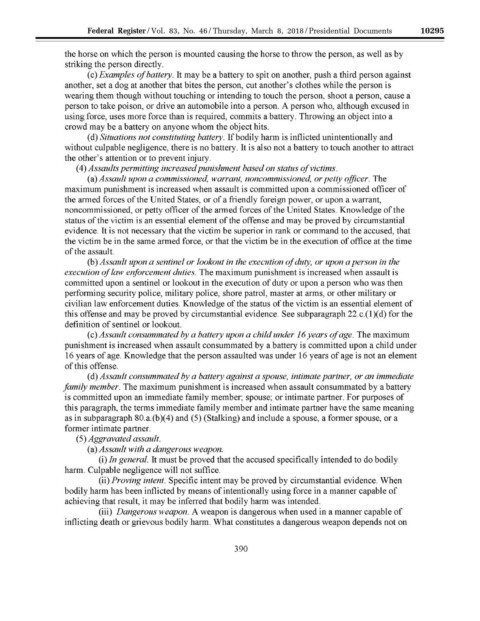Page 592 - Trump Executive Orders 2017-2021
P. 592
Federal Register / Vol. 83, No. 46 / Thursday, March 8, 2018 / Presidential Documents 10295
the horse on which the person is mounted causing the horse to throw the person, as well as by
striking the person directly.
(c) Examples ofbattay. It may be a battery to spit on another, push a third person against
another, set a dog at another that bites the person, cut another's clothes while the person is
wearing them though without touching or intending to touch the person, shoot a person, cause a
person to take poison, or drive an automobile into a person. A person who, although excused in
using force, uses more force than is required, commits a battery. Throwing an object into a
crowd may be a battery on anyone whom the object hits.
(d) Situations not constitutinK battery. If bodily harm is inflicted unintentionally and
without culpable negligence, there is no battery. It is also not a battery to touch another to attract
the other's attention or to prevent injmy.
( 4) Assaults permittinJ: increased punishment based on status~~ victims.
(a) Assault upon a commi.s·sionetl, warrant, noncommissioned, or pelly (?fficer. The
maximum punishment is increased when assault is committed upon a commissioned officer of
the am1ed forces of the United States, or of a friendly foreign power, or upon a warrant,
noncommissioned, or petty officer of the armed forces of the United States. Knowledge of the
status of the victim is an essential element of the offense and may be proved by circumstantial
evidence. It is not necessary that the victim be superior in rank or command to the accused, that
the victim be in the same armed force, or that the victim be in the execution of office at the time
of the assault.
(b) Assault upon a sentinel or lookout in the execution(?[ duty, or upon a person in the
execution (?f lmv er!forcement duties. The maximum punishment is increased when assault is
committed upon a sentinel or lookout in the execution of duty or upon a person who was then
performing security police, military police, shore patrol, master at arms, or other military or
civilian law enforcement duties. Knowledge of the status of the victim is an essential element of
this o±Iense and may be proved by circumstantial evidence. See subparagraph 22.c.( 1 )(d) for the
definition of sentinel or lookout.
(c) Assault consummated by a battery upon a child under 16 years of age. The maximum
punishment is increased when assault consummated by a battery is committed upon a child under
16 years of age. Knowledge that the person assaulted was under 16 years of age is not an element
of this offense.
(d) Assault consummated by a battel:Jl against a spouse, intimate partner, or an immediate
family member. The maximum punishment is increased when assault consummated by a battery
is committed upon an immediate family member; spouse; or intimate partner. For purposes of
this paragraph, the terms immediate family member and intimate partner have the same meaning
as in subparagraph 80.a.(b)(4) and (5) (Stalking) and include a spouse, a former spouse, or a
former intimate partner.
(5) Aggravated assault.
(a) Assault 1vith a dangerous weapon.
(i) In general. It must be proved that the accused specifically intended to do bodily
harm. Culpable negligence will not suffice.
(ii) Proving intent. Specific intent may be proved by circumstantial evidence. When
bodily harm has been inflicted by means of intentionally using force in a manner capable of
achieving that result, it may be inferred that bodily harm was intended.
(iii) DanJ:erous 11ieapon. A weapon is dangerous when used in a manner capable of
sradovich on DSK3GMQ082PROD with PRES DOCS VerDate Sep<11>2014 18:39 Mar 07, 2018 Jkt 244001 PO 00000 Frm 00409 Fmt 4705 Sfmt 4790 E:\FR\FM\08MRE0.SGM 08MRE0 ER08MR18.411</GPH>
inflicting death or grievous bodily hann. What constitutes a dangerous weapon depends not on
390

